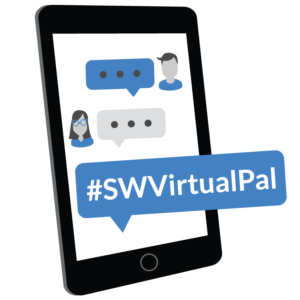Developing a Personalized Social Media Policy for Social Work Practice
Editor’s Note: This blog post is adapted from the Second Edition of the Social Media Toolkit for Social Work Field Educators.
There are many reasons for social workers to have a personalized social media policy – to maintain boundaries, protect privacy and confidentiality, and model professional behavior. To be clear, I am not referring to the policy that your organization or institution might have, directing the faculty, staff, and students on when it is okay to use social media, but one that you develop and follow as an individual practitioner, student, and/or educator. The purpose of a social media policy is to inform clients, students, colleagues, and others about when, how, and why you use social media in a professional capacity. From an ethical lens, this is a recommended practice per National Association of Social Worker’s (NASW) Technology in Social Work Practice Standard 2.10 – Social Media Policy and fits with the NASW Code of Ethics standards of informed consent with clients (1.3e-i), respect with colleagues (2.1), and when conducting supervision and consultation (3.1).
The following steps provide a guide for developing a social media policy that can be used as an assignment in a classroom with students or adapted for practitioners:
Internet Survival Guide for Social Workers
Agata Dera, MSW, is an Associate and Live Support Specialist with the Columbia School of Social Work’s (CSSW) Online Campus, where she works with social work faculty and students in online courses to optimize the digital learning environment. In this blog post, she shares tips and practices when connecting to the internet for online learning and engagement.
Introduction
At the Columbia School of Social Work (CSSW) my primary responsibility is to provide technical support to our online community. At the time of writing this piece, I have supported roughly 27 unique online social work courses at CSSW. In the last few years, I have offered technical guidance to hundreds of students, faculty members, Deans, guest speakers and other personnel.
As an award-winning online program, our goal is to provide our students with the highest quality of online learning in the most thought-provoking, innovative, engaging and accessible environment. One of the things that makes this possible is our program’s technology standards for hardware, particularly when it comes to internet connection. As part of our program’s tech requirements, students, faculty and guests connect to our live class sessions via Ethernet, (a wired connection to the internet), as opposed to Wi-fi, (a wireless connection). This allows us to design creative classrooms which focus on student growth while limiting any potential interruptions due to technical issues such as loss of internet connection.
In this post, you will find tips and resources about connecting to the internet, which I have found to be really useful. Please note that this post is based on my experience proving tech assistance to an online social work community, and its intention is to support anyone interested in learning more about the internet and ways to stabilize their connection.
Introducing our new @SWVirtualPal student co-hosts
Social Work Virtual Pal (#SWVirutal Pal) is a global and virtual community of practice for the social work profession, that digitizes the practice of having a pen pal for professional learning and networking. This community focuses on connection and collaboration among social work practitioners, students, and educators to offer the profession an opportunity to harness its collective knowledge for the greater good. Click here to learn more about Social Work Virtual Pal.
In this blog post, we, Dr. Amanda Taylor-Beswick (@amltaylor66) and Dr. Laurel Hitchcock (@laurelhitchcock), co-founders of Social Work Virtual Pal (@SWVirtualPal #SWVirtualPal), are delighted to introduce our new #SWVirtualPal co-hosts: Hannah Chambers, who is studying social work at the University at Buffalo School of Social Work, and Geoffery Kennedy, who is studying social work at the School of Social Work at Queen’s University Belfast. Hannah and Geoffery are aiming to reach out to as many social work students as possible as part of our contribution to connecting the profession; our efforts to support the development of strong and purposive professional relationships across the globe.
They are keen to connect with established student groups working to support learning and professional development; they are keen to unite to support student connections as part of the global social work educational requirements, from the International Federation of Social Workers, that outline how:
Ten Ways COVID-19 Created the Perfect Storm for Social Worker Burnout (and why I still have hope)
Editor’s note: This post was written by Melanie Sage from the University at Buffalo’s School of Social Work in response to the COVID-19 pandemic. She originally posted it on LinkedIn and is re-published here with her permission. This is a follow-up to her post – A Love Letter to Social Workers on the Front Lines of COVID-19. You can follow Melanie on Twitter at @melaniesage.
In April 2020, just months into the pandemic that changed the landscape of how we work and live globally, and in the face of concerted love to health workers, I wrote a love letter to social workers, the invisible heroes of the emerging pandemic. The letter spread like fire, viewed by more than 100,000 people. Many social workers resonated with the stories I shared and many people who work with social workers also expressed their gratitude for the steady dedication of social workers.
As we move into a new year, I feel called to update people about the state of affairs from my point of view. As a university professor, I do not work with clients directly. However, this past year, I have witnessed the impacts of COVID-19 on students, their families, and their clients. Despite instructors’ flexibility, we’re losing students like never before – they are leaving school, often without a word. Sometimes we hear; a family member has fallen sick or they just can’t manage homeschooling for their children, working from home, AND going to school online. Who can blame them for delaying their educational ambitions to take care of their families? For some, it’s not a matter of choice; it’s a matter of surviving these times.
For those students who have held on, the required social work internships have evolved dramatically. Social work students deliver services online, learn remotely, and show up to social services agencies in deep transition. Undoubtedly some innovation will come from this, but also some workers will leave and not return. Their education did not prepare them for the use of technology, for working from home, for the high risk of infection, for the chronic long term crisis work they face now.
How did COVID-19 create the perfect storm for social worker burnout? Social workers told me.




